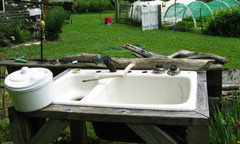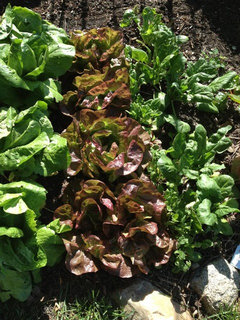How do you wash spinach and other prep sink questions
How do you folks wash mounds of spinach, chard or other greens and other vegetables? Do you use a big bowl or directly fill your sink with water or rinse each leaf or vegetable under the tap. I want to learn to this well and minimize bowls to clean and water usage. We typically buy from our CSA or farmer's market and I find greens and root veggies typically need 3 washes to fully get the mud out. My thrill with a huge bunch of fresh greens quickly turns to annoyance by the time I am done washing them when I look at my wet shirt, see the muddy dregs in my sink and see big bowl I used to wash that now has to be cleaned.
Context: So in my new kitchen we will have a prep sink and a clean up sink. Do I still need to bring out my big stainless bowl wash the greens 3 times or can I scrub the prep sink clean and fill with water and wash directly in the sink? Once the mud settles to the bottom, I can lift the leaves out to drain.
Comments (42)
a2gemini
11 years agoI consider the sink a contaminated zone and always use a bowl or spinner to clean my greens.
I am sure if you clean your sink, it would be fine...but after having serious food poisoning (not from our kitchen), I am extra cautious!mjsee
11 years agoI, too, assume the sink is contaminated. I use a big bowl and a spinner. For exactly the same reasons as a2gemini. Once you've had salmonella...
(not from my kitchen, either!)
Related Professionals
Leicester Kitchen & Bathroom Designers · Owasso Kitchen & Bathroom Designers · Forest Hill Kitchen & Bathroom Remodelers · Galena Park Kitchen & Bathroom Remodelers · Hoffman Estates Kitchen & Bathroom Remodelers · Independence Kitchen & Bathroom Remodelers · Jefferson Hills Kitchen & Bathroom Remodelers · League City Kitchen & Bathroom Remodelers · Luling Kitchen & Bathroom Remodelers · Rancho Palos Verdes Kitchen & Bathroom Remodelers · Billings Cabinets & Cabinetry · Kaneohe Cabinets & Cabinetry · Reading Cabinets & Cabinetry · North Plainfield Cabinets & Cabinetry · Des Moines Tile and Stone ContractorsCloud Swift
11 years agoWe have some big stainless bowls from the restaurant supply store. When I want to wash greens, I usually put them in one of those bowls and fill it with water. Often I put the faucet on spray so the spray can knock some of the dirt loose as it fills the bowl. Then I let the greens soak in the water for a few minutes to further loosen the dirt, then swish them around a bit, give the dirt/sand a bit of time to settle out and lift them out. I dump the water and rinse any grit out of the bowl. For spinach from the CSA and other dirty greens, I'll repeat.
My prep sink is deep and the bowl is sitting on the bottom of the sink so my shirt usually stays dry doing this. And the dirt from the bowl has washed down the drain so the sink doesn't need significant clean up.
If I'm preparing other produce, I'll often use the bowl several times for any produce that needs to be cleaned. It try to minimize rinsing directly under the faucet because I don't want to waste water.
If I'm going to spin the greens dry, I may use my salad spinner bowl for the soaking instead of one of the stainless steel ones.
Also some times I'll be prepping other produce while I let greens soak for a bit and this allows me to use the part of the sink not covered by the bowl for other things. I can toss peelings and non-useable stems/seeds into the prep sink as I go. If there is just a bit, I'll send them down the GD at the end and if there's a bunch, I'll put it into the bowl for a trip to the Green Waste barrel.
At the end of meal prep, the stainless bowl goes into the dishwasher or if it wasn't very dirty, gets a quick rinse and dry. That is less work than scrubbing the prep sink to the point where I'd comfortably use it for the purpose and I have a big prep sink so the bowl takes less water then filling the sink to a useable level would.
Like the other posters, I prefer to treat the prep sink surface as "contaminated".
williamsem
11 years agoWe use the spinner. Fill with water, swish and soak, then lift out the basket, drain, repeat, then spin dry. If the second rinse reveals significant amounts of grit, repeat again.
It's nice to hear I'm not the only one that considers the sink contaminated! I near about faint when we visit MIL and she drains potatoes or pasta by putting the pot opening against the sink as she pours.
gwlolo
Original Author11 years agoWe do not cook any meat at all. The prep sink is only used for vegetable and fruit washing.. Does that make that less icky? Even pasta water draining will be at the other sink.
Cloud swift- how big are your bowls. I often rinse as much as 2-3 lbsof greens or several pounds of carrots or tomatoes.
karin_mt
11 years agoI concur that the sink is dirtier than I would want, but I think a spray bleach solution would probably make it clean enough to use, especially if you are conscientious about keeping it clean.
We have a greenhouse and big gardens so the lettuce-washing routine is a familiar one around here (but so worth it for the home-grown yumminess!). Our method is similar to Cloud Swift's. I give greens a rinse in a colander and then soak them in big bowls of water. Usually two soaks does it for me. I think one of the keys is to lift the greens out of the water which helps to leave the grit at the bottom of the bowl.
For root veggies I put them in a mesh basket and spray them with the hose. After that I use those veggie scrubbing gloves which get carrots and potatoes sparkling clean.
All this veggie talk is making me wistful of harvest time. We have just a few week's worth of lettuce growing in the greenhouse before a long dry spell until late Feb.
Cloud Swift
11 years agoInterior dimensions 18 3/4" by 18 1/2" D shape and 10" deep (top to bottom) C-Tech-I.
User
11 years agoUsing either the sink or my restaurant sized stainless bowls, I fill 1/2 full of icy cold water, add a couple tablespoons of salt, stir til salt is disolved, dump in greens, sluice it all around until veggies are completely soaked, let sit for 5 mins, pour off salt water with out mixing in sediment from the bottom, rinse, and then dry with a salad spinner. Not once since finding this method have I had sandy/silty veggies or food poisoning, but as with everything in life, this is no guarantee!
If I am using the greens right away, I don't use the salad spinner to dry, as I generally add a bit of water to steam anyways.
MizLizzie
11 years agoBowl for me, unless it is an oversized mess of gritty collards. THEN I first scrub sink with Comet (which I try to limit use of) and then spritz with my handy dandy bottle of rubbing alcohol. THEN rinse sink with water.
Yep, salmonella taught me to be paranoid. In my case, my poor sister got it. Watching her suffer was all the lesson I needed. I even wash mushrooms, which I know gourmet cooks would shame me for doing. Can't help it.
sandra_zone6
11 years agoI wash everything, including mushrooms and all 'prewashed', packaged stuff... It's not just the dirt and pesticides I worry about, it's all those dirty hands that touch the stuff to box, unbox, load onto displays that I worry about.
I rinse first in a colander to remove loose grit, then put lukewarm water in a bowl, add a drop of soap (nothing anti-bacterial in my home) thenn drop the colander in it. Swish around, let soak for a bit, raise the colander, dump water, add cool water and repeat for 2 - 3 rinses. Been doing it the same way for 20 years or more. Really creeps me out when I see a cook who doesn't wash...
lazy_gardens
11 years agoIf farmers sell "washed" vegetables, they usually have a pile of regulations to deal with. If they sell "unwashed" they don't, which is why you are getting all that dirt. Even a quick rinse counts as 'washing".
If they are that muddy, do the first wash outside, with a garden hose and a strong spray. Put them in a net container, such as a collapsible laundry basket, and hose them down, shake them around and hose again.
My farm-living relatives had a utility sink on the back porch for these fresh-picked and dirty things. Cold water only, and it drained to the pond.
I use a plastic dishpan and put a drop of dishwashing detergent in the wash water (this makes the dirt and bugs turn loose of the veggies). Dump in the greens and slosh around with my hands.
Lift out greens into colander and rinse again.
mabeldingeldine_gw
11 years agoLike KarinMT, I have a big garden and hoophouse, so have lots of home grown goodness to wash. If I have a huge batch, I will clean the sink, give a final spritz with my rubbing alcohol sprayer and wipe dry with a clean towel. I then add as much water as needed to submerge everything, and lift out into my salad spinner or a colander and repeat if needed (rarely). For large batches I will lift greens into the colander, let them drain, then spread them on clean flour-sack type towels to further dry before storing or prepping blanching/freezing. My hoophouse tends to keep greens cleaner with no mud splashing onto the leaves.
Otherwise, I let things soak in a very large bowl, repeat as needed, and spin dry in the salad spinner. In the spring and summer, I have a garden sink I use for my first rinse of greens and vegetables.
Can't wait for my garden to begin producing again!

This post was edited by mabeldingeldine on Thu, Jan 3, 13 at 10:07
Bunny
11 years agojustmakeit and Nancy, I've never thought of my sink as contaminated. =:O Nevertheless, it's too big to fill with water for veggie washing. In fact the only time I can remember filling it is to wash burner grates.
I use a bowl or large pot for rinsing veggies.
zeebee
11 years agoSmall bundles of spinach I do in a bowl. Larger amounts, like piles of collards and mustard greens, go into a well-scrubbed sink (my greens cook for hours which should burn off any lingering sink germs). I use lukewarm water and a handful of salt or baking soda. Dunk greens and swish well, lift out greens and drain into colander, empty bowl/sink of dirty water, repeat until water is clear, then repeat once more.
cottonpenny
11 years agoI wash my sink the same way I wash my big bowls and cutting boards, with hot water and a soapy sponge, so not sure why I would think it's more contaminated than any other thing. I also don't dump raw chicken juice in there and then wash lettuce, though.
I got this expensive sink specifically for washing greens and veggies. I fill it up, then lift the greens out to the built-in colander and the water drains into a drain instead of all over my counter/floor/shirt/iPhone/dog. I love it!
Here is a link that might be useful: Franke Beach
liriodendron
11 years agoMabelD,
Ok, can I ask more about your hoop houses:
Sizes; seasonal cropping rotations; coverings? I am trying to refine my use of ours and eager to hear other peoples' experiences!
I have an outdoor sink, too, served by a hose. It's my first line of cleaning, especially for root veg and greens, before stuff comes into my house. It drains directly down into the ground as I never use anything but water in it.
The catch basin for the sink discharge is just a big hole loosely re-filled with chunky rocks. Eventually the dirt washed off and down the drain will silt it up and I'll have to re-dig it.
Inside I just use large stainless bowls (18-24" in diameter) for rinsing/washing greens and then a spinner. I never thought of my clean sink as being contaminated; it's just more convenient to have the process sequestered in a container. Sometimes if the produce is really dirty (or it's already too cold for the outdoor sink plumbing), I'll just use luke warm water in a bucket outdoors on the porch for the first pass - and then just heave the rinse water and its accompanying dirt on the lawn in order to avoid extra dirt going down into my precarious ancient septic system. For produce purchased at the market, it's usually already cleaned enough to go straight to the inside washing stage.
What one poster referred to above about the complicated regulations for farm-washed/rinsed produce offered for sale is accurate. As soon as you use water to rinse - or more commonly to remove field heat from freshly harvested vegetables - you activate rules for meticulous water-quality testing. This is because water is not only a means of cleaning veg, it is also potentially a significant vector of food-borne illness pathogens.
One the reasons I prefer to grow my own veg is to avoid risk of water-borne pathogens and fertilizer/ pesticide run-off contamination of the on-farm rinsing and cooling water used in large-scale food production agriculture.
Hoping to hear more about hoop house strategies, and apologies for wandering off topic. If Mabel, or others, want to enlarge on this topic we can take it to a gardening forum, or make a separate thread in conversations. Hoop houses are da bomb!
L.
gwlolo
Original Author11 years agoSo I guess the question is also about sink cleaning practices. How do you all clean your's?
For my prep sink, I was planning to wash it just like I would a prep bowl - scrub with dish soap, rinse all of the soap off. After reading about it here, I also keep a spray bottle of diluted alchohol for a sanitizing spray and wipe down. The sink stopper etc., go into the dishwasher. I too have an old cement outdoor sink that I have jerryrigged a hose wash option. I usually use that only for home grown veggies. I don't grow enough and hence the veggies from CSA and farmer's market.
Cottonpenny - How is Franke beach working out for you? Do you use all the accessories? Any pics to share?
a2gemini
11 years agomabel - I am drooling over your hoop house! I peeled back 8 inches of snow and plucked a bundle of swiss chard and added to my soup. Wow - and if I had a hoop house...
The snow was clean by the garden (aka no dog, skunk, raccoon piddle... but I did rinse it anyway)
mabeldingeldine_gw
11 years agoLiriodendron, I love those low hoops. I use them for season extension, pest control, and shade protection. The low hoops in the above photo are made from pvc conduit slipped over a length of rebar pushed into the ground. I also have a much larger hoophouse made in a similar fashion. with the large hoophouse, I can be eating overwintered greens in March, with the low hoops, a bit later. I've had lettuce as early as May 1 from the low hoops. I think they work best for fall seeds started to overwinter such as spinach.
I have a blog that has a lot more details. The blog was not very active last summer/fall while I was traveling, but I'm planning to be back at it this year.
Here is a link that might be useful: Henbogle
kitchendetective
11 years agoBatches and batches and batches in the salad spinner, but if that 13lbs. were a promise, I might shoot for the campylobacter. ;10% bleach solution, in answer to your other question. Let sit 20 minutes. Rinse well.
mabeldingeldine_gw
11 years agoa2gemini -- I was traveling all summer and didn't get any fall greens planted, so I am jealous of your chard! Try the hoops, you will love them!
laughablemoments
11 years agoWe use the same spinner Mabeldingeldine has on her outdoor sink. It has a colander inside, so I flop my greens into the colander, spray them down with my sink sprayer, tossing them around a bit under the running water, and do a final spin with the lid on while running water through the hole in the top.
Hoop house. Sigh. We had hoped to garden in ours for the last few years but there were too many other projects demanding our time. Last year DH put it up (also rebar and PVC, covered with a heavy duty greenhouse plastic) faced the open ends so that the wind would flow through easily, and filled it with fire wood. It dries the wood great. The sun cooks it all year long, and the wind whisks away the moisture. But alas, no fresh veggies in winter. Maybe someday we'll get a second one up.
camphappy
11 years agoI'm thinking like cottonpenny. If you wash your sink the same way you wash your bowls. spinner. cutting boards, what is the difference of washing the greens directly in the sink or in a bowl?
How wonderful that so many of you grow your own veggies! I have too many trees on my property and very little sun.
a2gemini
11 years agoIt is hard to put your sink into the DW. Everything but my wood cutting board goes into the DW. I know it cleans things better than I can do. For those of you who use your sink - I would recommend a yogurt a day. it keeps the bad bacteria from latching onto your intestinal track - really - yes - When I first heard it I just laughed and then I read more and it makes total sense! I use good yogurts and try to minimize sugar (sometimes I make my own - but I need to start a new culture.
Campy - our garden was a funny story - we had a bad case of grubs and the grubs ruined much of our lawn and once spot was worse than the others areas - I noticed it was the only sunny and almost flat area in the yard - and now it is our small but lucrative veggie garden.Spring lettuce crop

Then we had the drought and I spent more watering my garden than came out of the garden... But still harvesting chard from under the snow!I think my garden might be 8-10 feet wide and 6-8 feet deep. I had a banner crop of pole beans, arugula, lettuce, spinach, and habanero peppers (my neighbor gave me plants!) My tomatoes were good but not as great as other years. My winter squash was a failure this year with only a few mini squash.
gwlolo
Original Author11 years agoA2gemini- completely agree o the yogurt. We make it at home at eat it everyday. That is some fresh lettuce there! I love to make salad with just picked lettuce. Can't wait to have a vegetable bed again.
mabeldingeldine_gw
11 years agoGorgeous lettuce! I've been making my seed list and am getting garden fever!
Laughable, try some floating row cover over the plants under the hoops in the winter -- you'd be amazed what will survive. I've had great success with Olympia spinach for overwintering.
karin_mt
11 years agoOK, no fair posting pictures of succulent lettuce in the dead of winter. :)
But all this talk of greens has sent me out to the greenhouse on this sunny day. I will have to harvest one of the remaining heads of lettuce for a salad tonight.
+1 on the idea of covering your greens in the fall and see what you might get in the spring. The plants are likely to pop back to life in March giving you the earliest possible spring salad.
lazy_gardens
11 years agoTo sanitize a sink, use what laboratories use: Bleach in water (2 cups of bleach in a gallon of water is strong enough). Spray and let it set a few minutes, then wipe with a clean cloth.
It will kill anything you need to worry about.
sunnycb02
11 years agoWhy are all your sinks contaminated? I don't eat or prepare meat, is there another reason I'm missing?
Bunny
11 years agoWasn't there a terrible episode of salmonella with alfalfa sprouts? I think there can be bacteria, chemicals and myriad nasty stuff riding in on non-meat items.
gwlolo
Original Author11 years agoLast year, there was Ecoli episode in CA and the culprit were wild pigs which has visited the spinach patch. The interesting thing was that the ecoli was not on the spinach it was inside the spinach. The pigs contaminated the soil and the water was as absorbed by the spinach roots and the bacteria was inside the leaves.. So no amount of surface rinsing would have removed or killed the Ecoli. Thankfully, it was a small episode that was quickly contained. The triple washed baby spinach salad bags were quickly pulled from the shelves.
Since I first posted, we just finished the countertop and sink install. I have hole for 1 soap dispenser at the sink and plan to keep a spray bottle of alcohol or bleach solution for disinfecting. I have the same sink as cottonpenny and plan to use the sink bowl as the rinse bowl after a cleaning disinfecting routine.
Circus Peanut
11 years agoYikes -- bleach is as poisonous to the human system as anything it's trying to eradicate. We use hot water and baking soda to clean our sinks, and a large salad spinner with its integral colander to soak, rinse and spin our spinach & greens. Spinner goes right into the dishwasher.
sunnycb02
11 years agoI was thinking the same thing about bleach! That is sure an interesting story though about the spinach.
Bunny
11 years agoI used to work in my local health department. In the proper proportions, bleach is your friend.
Use a mixture of 3/4 teaspoon liquid bleach per quart of water, or one tablespoon bleach per gallon of water, to ensure protection against bacteria on surfaces. Flood the surface with the solution, and let it stand for several minutes. Then, rinse the surface with clean water and air dry or pat dry using fresh paper towels. Bleach solutions lose their effectiveness overtime, so throw them away after one week. Wash cutting boards, dishes, utensils and countertops with hot water and sanitizer after handling each food item and before preparing the next food.
marcolo
11 years agoKitchen sinks carry more bacteria than public toilets. Would you go to the bus station and wash your salad in the toilet?
This isn't a "peck of dirt" question. Nobody needs to eat a peck of salmonella, e. coli or campylobacter. Industrial farming has made these pathogens far more common than when I was a kid, so what your grandma did doesn't matter.
User
11 years agoI don't know how I have lived this long :) Oh well...here are some links to surprising info on where the bugs are worst !
Oh..and for those of you using water hoses outside NO !! If you read the data on the amount of germs in a "hose pipe" as we call them in the South you will never ever drink or wash anything that is going into your mouth in it ever again. There are specially treated hoses but I bet most of you don't have them. Never wash your veggies outdoors at that wonderful outdoor sink with the hose :)
12 germiest places :
Here is a link that might be useful: kitchen sink worse than a public bathroom



















sushipup1